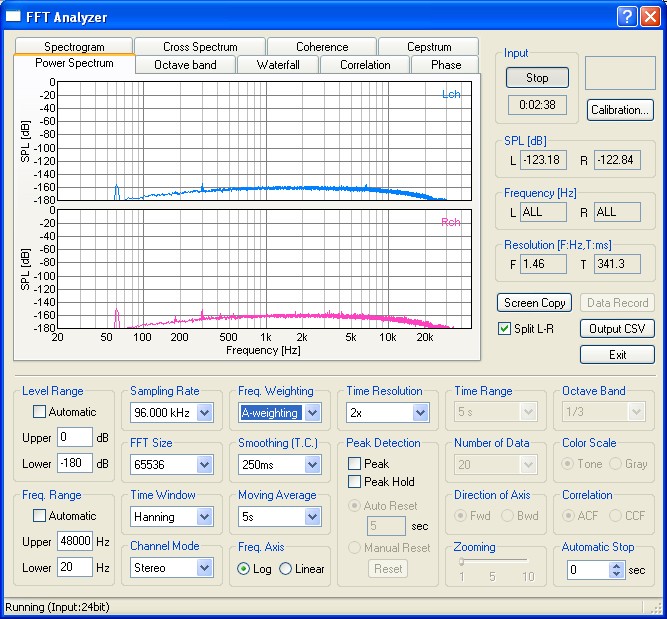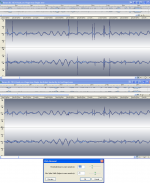I don't want to burn CDs. I don't even know if I will want to do much other than record, declick* and save as FLAC. I first bought a sound card to play with ripping vinyl in 1999 and never used that!
A good eq would be of interest once I work out what would actually be useful and if the end result is worth the bother. But I understand this sort of thing is available in all flavours as VST plugins.
* I am one of those where a tick on live playback doesn't bother me, but on a recording where it always comes at the same time it annoys me.
A good eq would be of interest once I work out what would actually be useful and if the end result is worth the bother. But I understand this sort of thing is available in all flavours as VST plugins.
* I am one of those where a tick on live playback doesn't bother me, but on a recording where it always comes at the same time it annoys me.
Hi Bill
Audacity “Click removal” effect does a decent job.
For a one LP side recording (24b/96KHz) it takes 3 minutes to do (enter into Audacity, open file, declick, export file, exit Audacity)
With just the standard settings, it takes away the HF content of the artifacts without affecting the HF content of the music. Fiddling with the settings, it may do a better job. Try it.
🙂
George
Audacity “Click removal” effect does a decent job.
For a one LP side recording (24b/96KHz) it takes 3 minutes to do (enter into Audacity, open file, declick, export file, exit Audacity)
With just the standard settings, it takes away the HF content of the artifacts without affecting the HF content of the music. Fiddling with the settings, it may do a better job. Try it.
🙂
George
Attachments
I will (one I have a few things in place like an ADC). I have worked out the test album. I have a very kn*ckered copy of 'the sound of bread' which I inherited after my sister had played it to death. Not everyone's cup of tea but relatively sparse recording so the ticks are very obvious. BTW I found an interesting link last night on spectral declicking with Reaper using spectro Declicking in REAPER? - Cockos Incorporated Forums
Hard work, but worth trying, even if it's to dismiss as not worth it! Confusingly there are two products called spectro. Spectro Stillwell Audio is the one.
Hard work, but worth trying, even if it's to dismiss as not worth it! Confusingly there are two products called spectro. Spectro Stillwell Audio is the one.
You can readily use the DL-103 Mahler file Bill.
I doubt your LPs are that badly scratched and popped as that 😀
George
I doubt your LPs are that badly scratched and popped as that 😀
George
You'd be suprised. I even tried treating this one with Armour all. A bad mistake I will not repeat. But maybe should try both!
I wanted to share with all of you why I recommend the TI PCM4222 Evaluation Module.
This is an unweighted FFT of the PCM4222EVM at 96 kHz with open inputs.

With A-weighting the noise floor is within a dB of the published -124 dBFS.

At $149 for a bare board the PCM4222EVM is a good value for the level of performance with AES, SPDIF and serial audio interface.
The above FFTs were measured with a Meanwell 25W desktop "brick" PSU having +5 and ±15V outputs. (P25A14E-R1BU now the Meanwell GP25A14E-R1B)
The input overload is about +15 dBu (4.5 V RMS) so it's got plenty of headroom for flat recording.
Mate the PCM4222EVM with a flat preamp, box and the Meanwell PSU and you're good to go.
This is an unweighted FFT of the PCM4222EVM at 96 kHz with open inputs.

With A-weighting the noise floor is within a dB of the published -124 dBFS.

At $149 for a bare board the PCM4222EVM is a good value for the level of performance with AES, SPDIF and serial audio interface.
The above FFTs were measured with a Meanwell 25W desktop "brick" PSU having +5 and ±15V outputs. (P25A14E-R1BU now the Meanwell GP25A14E-R1B)
The input overload is about +15 dBu (4.5 V RMS) so it's got plenty of headroom for flat recording.
Mate the PCM4222EVM with a flat preamp, box and the Meanwell PSU and you're good to go.
Last edited:
Very nice Wayne.
What is the 0dB in Vrms?
George
Thank you George.
The (YMEC) analyzer scale is dBFS.
0 dBFS is 4.5 V RMS on the PCM4222EVM.
That is rather good. I will add one to my xmas list... I can also power it from my silent switcher.
That is rather good. I will add one to my xmas list... I can also power it from my silent switcher.
I stopped buying data converters on specs alone a long time ago, but only after having been very disappointed when shiny new toys sounded bad. So far as I am aware, even Bruno Putzey believes in listening tests, despite that he can measure performance accurately as well.
Hi Bill
Audacity “Click removal” effect does a decent job.
For a one LP side recording (24b/96KHz) it takes 3 minutes to do (enter into Audacity, open file, declick, export file, exit Audacity)
With just the standard settings, it takes away the HF content of the artifacts without affecting the HF content of the music. Fiddling with the settings, it may do a better job. Try it.
🙂
George
IIRC Audacity uses spectral signature to identify the clicks which according to the paper Bill posted is inferior to statistical. I found ClickFix (free) better but only for Audition or Cool Edit.
Just checked, Audacity won't allow individual click removal (maybe the repair effect works for that?) and silence with a full scale pop (passed through RIAA) in the middle came back with no change. This means that your results before vs. after RIAA with this tool are going to be more extreme (my guess).
I already posted that picture of the huge discontinuity repaired by ClickFix in one of these threads. My experience has been that any tool used over long sections of music has to be tuned by ear especially if it's full of pops. For those with patience and say one or two bad pops per minute I would do the individual removal only or at least first.
ClickFix has an aggressive mode where you identify the damaged spot so it goes right into the recursive restoration the results as I posted are amazing.
Clickfix webpage: ClickFix for Adobe Audition and Cool Edit - Home
Thanks, I forgot that. Just put it on a new Win 10 laptop with my 16yr. old copy of CoolEdit and they still work. Best $50 I ever spent, though I hear the old versions status is sort of in limbo and there has been no action out of Adobe to stop free downloads and license keys.
The ability to zoom in and out vertically and horizontally down to individual sample values with only the mouse and get instant response (I've loaded 10 hours of recording into one big file at times) I just can't give up.
Last edited:
WRT Converter Specs vs. Sound. My interest in the PCM4222 began looking for a good converter to be used for instrumentation. It's difficult to find internal or external interfaces that use them because they are so expensive.
Ross Martin, DIY and ebay seem to have the only affordable devices that use them. Ross Martin's PCM4222 and PCM1794 converters have a following in the mastering community. They are a bargain.
I'm not going to comment on the sound because I'm not an expert and don't have enough listening experience but I can tell you that it gives me lots of measurement DR, with low distortion and without a lot of out-of-band noise. Since its not USB there's also galvanic isolation.
I was quite pleased however with my first rip yesterday using it because it's increased DR and headroom let me increase gain by about 7 dB.
I've bought one awful USB-based converter for instrumentation and stopped looking after I found the TI eval board.
Ross Martin, DIY and ebay seem to have the only affordable devices that use them. Ross Martin's PCM4222 and PCM1794 converters have a following in the mastering community. They are a bargain.
I'm not going to comment on the sound because I'm not an expert and don't have enough listening experience but I can tell you that it gives me lots of measurement DR, with low distortion and without a lot of out-of-band noise. Since its not USB there's also galvanic isolation.
I was quite pleased however with my first rip yesterday using it because it's increased DR and headroom let me increase gain by about 7 dB.
I've bought one awful USB-based converter for instrumentation and stopped looking after I found the TI eval board.
Last edited:
I stopped buying data converters on specs alone a long time ago, but only after having been very disappointed when shiny new toys sounded bad. So far as I am aware, even Bruno Putzey believes in listening tests, despite that he can measure performance accurately as well.
I should be clear that I don't think I would be able to hear the difference between that and the onboard ADC in my miniDSP. However it does potentially kill 2 birds with one stone as I can go AES/EBU into miniDSP and std SPDIF into laptop for recording. It also is more sensible input levels than the miniDSP differential input meaning less gain required from flat pre-amp. Oh and I can save up for it and run it off batteries. So far WNTL. Then add the fact that it makes input selection easier due to the unique way miniDSP works and its almost a no brainer.
I am not sure what Bruno 'actually believes' as he does need to do marketing. But he is clear that, in his view, the better it measures, the better it sounds.
I should be clear that I don't think I would be able to hear the difference between that and the onboard ADC in my miniDSP.
My first experimental signal chain was FET source followers - Tascam mic pre's as flat gain - line out to miniDSP RIAA - laptop headphone out.
It sounded more than OK and noise was not an issue. This signal chain would make many cringe.
Just checked, Audacity won't allow individual click removal (maybe the repair effect works for that?)
Yes.
My first experimental signal chain was FET source followers - Tascam mic pre's as flat gain - line out to miniDSP RIAA - laptop headphone out.
It sounded more than OK and noise was not an issue. This signal chain would make many cringe.
Okay, maybe great for listening, but not as great for instrumentation? Heck, FET source followers are sometimes used as output buffers for guitar pedals, and they can sound quite good for that type of use.
Okay, maybe great for listening, but not as great for instrumentation? Heck, FET source followers are sometimes used as output buffers for guitar pedals, and they can sound quite good for that type of use.
Remember at unamplified phono level they are better than -90dB about the same thing that goes in a Schoeps $2000 mic.
Yes.
But it must be less than 128 samples, so definitely only really useful before RIAA.
- Status
- Not open for further replies.
- Home
- Source & Line
- Analogue Source
- Digitizing vinyl
